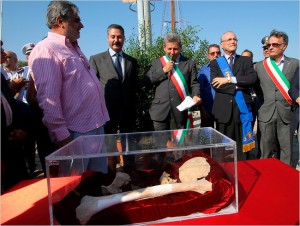 Saturday a few pieces of Caravaggio (maybe) were placed reverently on red velvet pillow in a crystal urn and carried to Porto Ercole on a tall ship in tribute to the final sea voyage that brought Caravaggio to Porto Ercole in 1610. Some fragments of his skull, a piece of femur, and part of the base of his spine were given a hero’s welcome by the crowd.
Saturday a few pieces of Caravaggio (maybe) were placed reverently on red velvet pillow in a crystal urn and carried to Porto Ercole on a tall ship in tribute to the final sea voyage that brought Caravaggio to Porto Ercole in 1610. Some fragments of his skull, a piece of femur, and part of the base of his spine were given a hero’s welcome by the crowd.
Some people, however, are less than gruntled at the spectacle and at the weak scholarship/shameless tourism-grubbing behind it.
“It’s a put-on that offends the intelligence of people,” said Vincenzo Pacelli, an art historian and scholar of Caravaggio’s final days, accusing the committee of perpetrating an urban legend.
Other critics suggested that as the Italian government seeks to exploit the economic potential of the country’s cultural resources, marketing is trumping serious study.
“In the 400th anniversary of Caravaggio’s death, this committee has concocted a compelling discovery thinking it will attract tourists,” said Tomaso Montanari, who teaches 17th-century art at the University of Naples. “It’s all very depressing.”
Since there was no solid DNA to compare, we really don’t know if it’s him. Then there’s the question of whether exhuming bones of dead luminaries is a worthy endeavor in the first place. After all, we still don’t quite know what killed him. Mr. Vincenti, the leader of the project, thinks Caravaggio died of lead poisoning from handling lead paints, the committee that ran the project pins it on sunstroke hammering his syphilis-weakened body.
Vincenti doesn’t bother to deny the drama is good business for the area. Quite the opposite, in fact.
Mr. Vinceti did not seem to be arguing on Saturday when he said: “It doesn’t end here, Tuscany and Lombardy are about to launch a cultural tourism initiative so that Caravaggio lovers can come to Italy and revisit the places where he lived. We need to promote the great wealth that Italy has in its art and culture.”
Hey, we all gotta make a living, amirite?